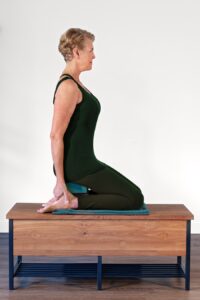With the shortest day of the year approaching, we feel the cold and dark of winter wrapping around us. There is no better time to harness the power of the breath to illuminate and feed our inner fires.
Pranayama is the term for the breathing techniques developed by the ancient yogis to work with the essential energy — the life force, or prana — of the body. Kapalabhati is one of them. It involves short powerful exhales and gentle inhales. The roots of the word mean “skull lightening,” and doing it you might imagine you are cleaning out the cobwebs and polishing your brain. It is energizing and can lift your emotional state. And it really can warm you up.
The list of benefits of this kind of breathing is long, but there are also several contraindications to consider: you shouldn’t do this if you are pregnant or have digestive or abdominal irritation, a respiratory infection, vertigo or epilepsy, high blood pressure, heart disease, a pacemaker, or glaucoma.
To do this pranayama, begin by sitting comfortably with a long, straight spine. You may sit cross-legged, in a chair, or kneeling, seated on a couple of blocks, as I am in the photo. Begin by practicing some easy, long, slow breaths in and out. Inhale and exhale through the nostrils with your lips sealed.

After a few easy breaths, place one hand on your belly. On your next exhalation, draw in the muscles of the lower abdomen rapidly, creating a quick, strong exhalation; then relax the belly, and your inhalation will happen naturally. It will be a somewhat slower inhale, happening with no effort. Then repeat with another quick exhale by drawing the belly in rapidly. Release it, and feel an easy passive inhale.
This may feel strange. The reason is that it’s the opposite of how we usually breathe, with our inhalations relatively active and our exhalations passive.
If you are having trouble drawing in your lower belly, place both hands on your abdomen, and while you exhale, use your hands to push the belly in. Release your hands on the inhale.
Start out slowly; as you become more adept at contracting and releasing your lower belly you can speed up the pace. Try 20 to 25 breaths at first. Afterwards notice your inner landscape. Do you feel the breath’s warming power? You may gradually increase the number of cycles of Kapalabhati as you get more comfortable with it. Experienced yogis do up to a hundred cycles at a time — but that’s not recommended for beginners.
The ancient yogis theorized that the universe is made up of both energy, prana, and awareness, chita. They believed that when both flow freely through the body we experience good physical health, inner peace, clarity of mind, and spiritual awakening. They developed eight systems of practice to enhance their flow, and these are now referred to as the eight “limbs” of yoga. Most students I work with are familiar with asana, the yoga postures; that’s just one limb. Pranayama, or breath work, is another limb. I’ll leave the other six for another time.
Although it is enough for some people to know that pranayama is rooted in ancient philosophy, I know others who would rather hear that there’s plenty of modern-day scientific research pointing to the effectiveness of breath techniques for reducing stress and improving mental acuity and sleep. For those seeking western culture’s view, I recommend “Research: Why Breathing Is So Effective at Reducing Stress,” an article published in the Harvard Business Review in September 2020.
Whatever inspires you, I hope that by stoking your inner fires you’ll stay warm and bright through this holiday season.



